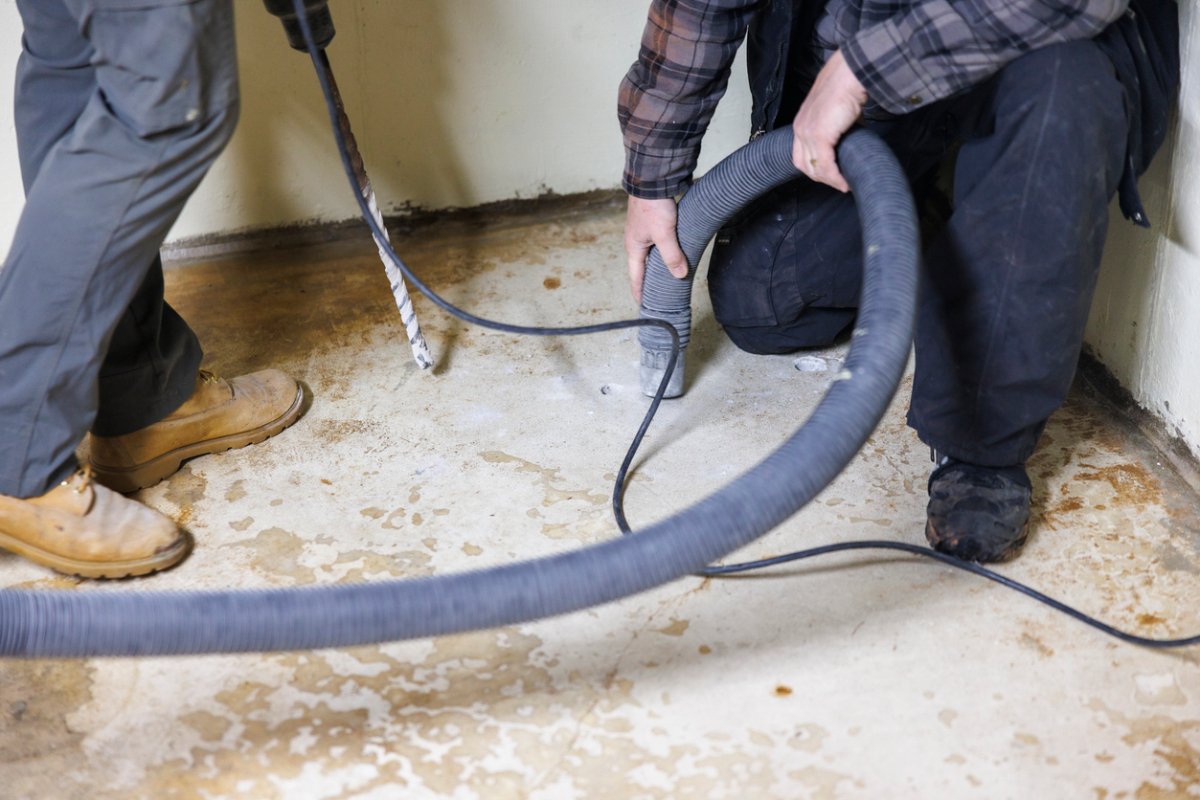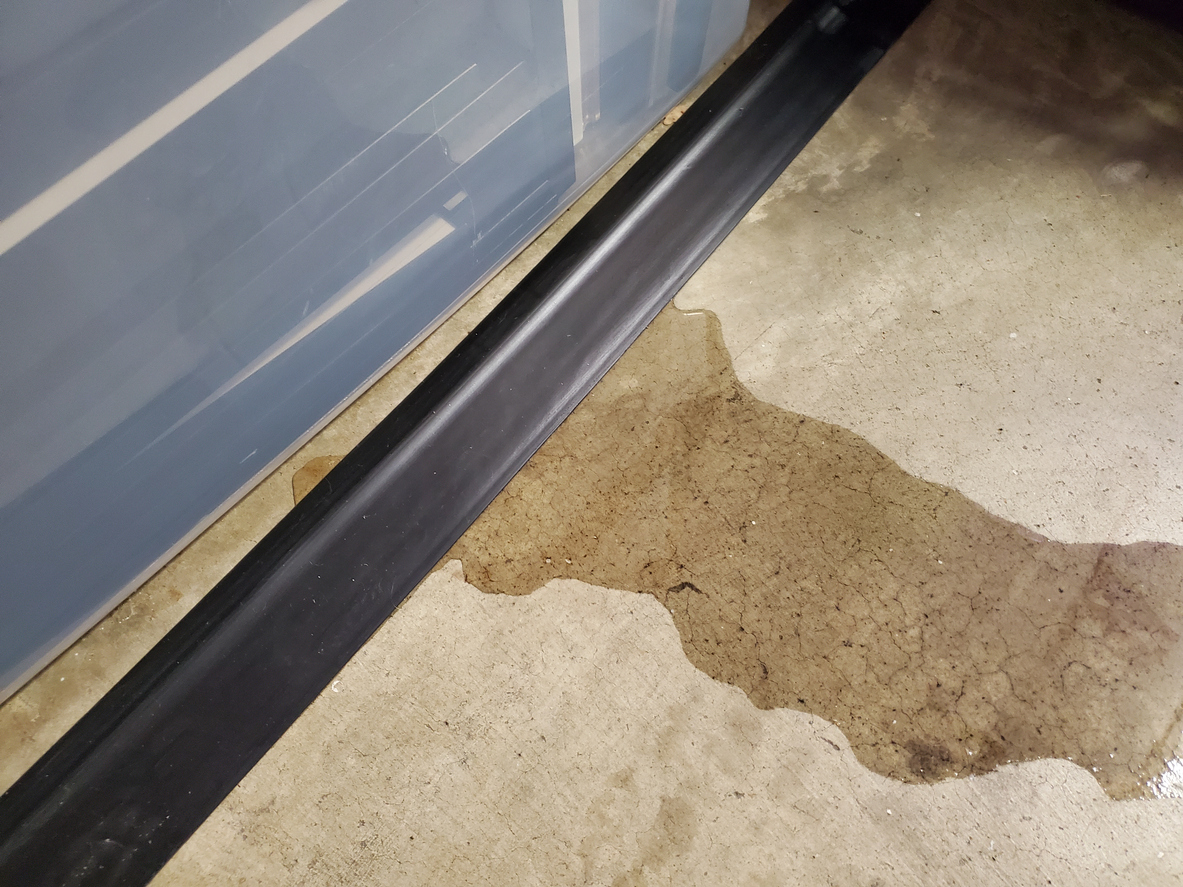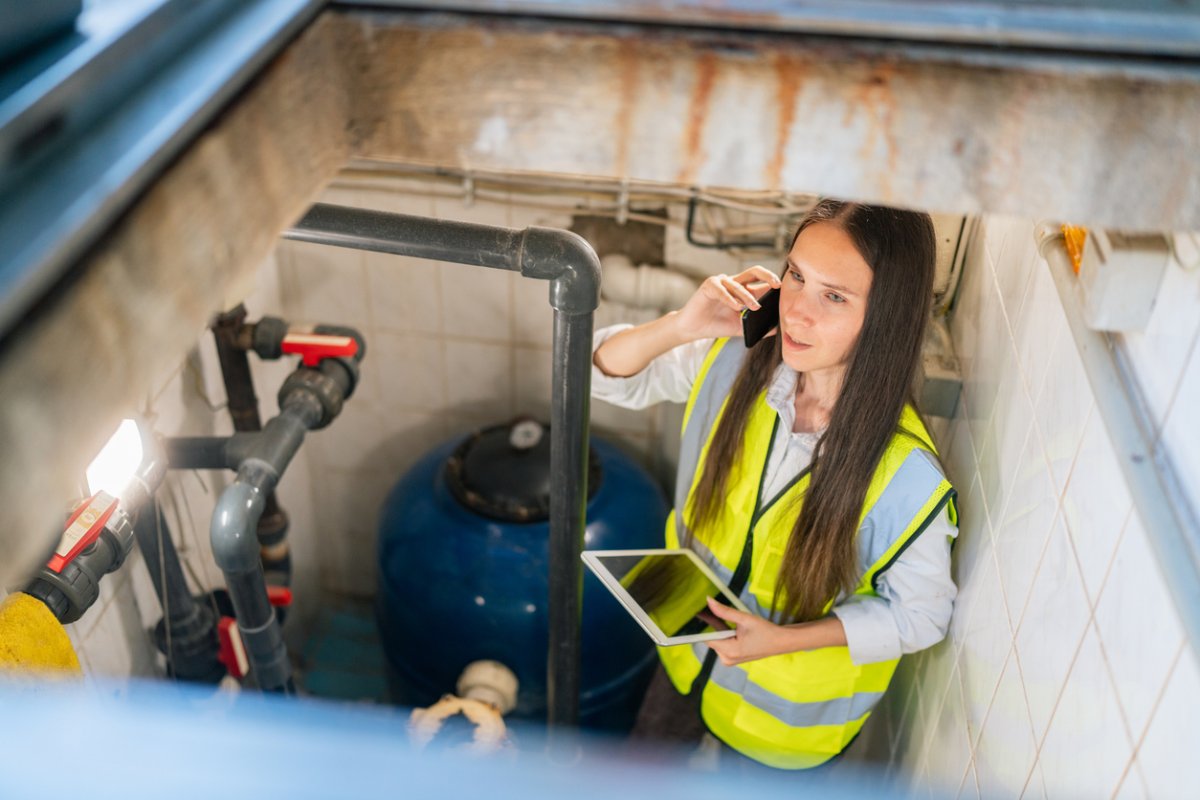

We may earn revenue from the products available on this page and participate in affiliate programs. Learn More ›
What You Need to Know
- Water leaks underground are typically the result of damaged or worn-out plumbing lines.
- Some signs of underground water leaks are a sudden increase in water bills, decreased water pressure, sounds of running water when faucets are turned off, and damp spots on flooring or in the yard.
- Underground leak detection methods include turning off and monitoring the home’s water supply, observing water levels in appliances and toilets, looking for damp spots around the home or yard, checking for cracks in concrete surfaces, using thermal imaging devices, and having a plumbing inspection.
- Leaks in the home’s plumbing will need to be dealt with by a professional plumber. If the home has sustained water damage due to the leak, it’s best to hire a water damage restoration company to prevent mold growth or structural damage.
When a homeowner identifies signs of a water leak on their property, one of the first things they’ll do is try to figure out where it’s coming from. Occasionally, they will discover an underground water pipe leakage. However, because these leaks are hidden beneath the surface, homeowners wouldn’t have any reason to investigate them until there’s a problem.
For those wondering how to find a water leak underground, there are plenty of ways to do so without excavating. Once the problem is identified, the best plumbing services like Mr. Rooter or Roto-Rooter can be relied upon to confirm the source of the leak and make any necessary repairs.
Tools & Materials
Bobvila.com may earn a commission from purchases made through these links.
Causes of Water Leaks Underground
Common culprits of underground water leaks include pipe corrosion, soil shifts, tree root intrusion, and fluctuating temperatures. All of these issues can lead to pipe expansion and contraction, causing a leak to occur
Underground water lines typically last anywhere from 50 to 100 years depending on the material used. For instance, clay pipes might have a lifespan at the lower end of this range, while materials such as copper, ductile iron, and new PVC models can last much longer. However, unexpected factors can cause a leak at any point in a pipe’s life, making regular monitoring and maintenance essential for early water leak detection and repair.
Signs of Water Leaks Underground
An underground water leak can go undetected for weeks, months, or even years depending on the size and location. According to Mehdi Khachani, CEO and founder of Miami-based JMK Plumbing, there are several telltale signs that an underground water pipe is broken, including an unexpected increase in water bills, a sudden drop in water pressure, and pools of water or soggy spots in the landscape, especially when it hasn’t been rainy. Homeowners may also hear a faint sound of running water when all taps are off or notice lush patches of green grass in very warm areas of the property. If left unaddressed, these leaks can cause severe property damage and potential health risks from growing mold and mildew.

Before You Begin…
Water pipe leak detection can be simple enough, but the subsequent repairs typically require specialized equipment and plumbing expertise. The average homeowner is advised not to attempt to repair a water leak issue on their own. It’s a good idea to have a plumber confirm the cause and location of any leaks that are identified to ensure that the problem is handled properly.
If a homeowner is adamant about finding underground water leaks on their own before hiring a plumber, it’s important to verify the location of all utility lines before digging to avoid disrupting services or causing accidents. Homeowners will also want to be aware of local regulations or permits required before attempting water main leak detection and repair.
Safety Considerations
- Excavating near electrical, gas, or other hazardous lines can be dangerous and will need to be handled by a plumber.
- Water damage from plumbing leaks can lead to mold growth, which can cause adverse health effects in sensitive individuals. It’s generally best to leave mold cleanup to a professional remediation company.
STEP 1: Turn off the home’s water supply valve and check the meter to confirm that there is a leak in the plumbing system.
The first critical step when detecting a water leak is to turn off the property’s main water supply valve. This will halt the flow of water throughout the property, allowing for a more precise assessment of the situation. The next move is to observe the water meter closely. If the meter shows movement or usage despite all water being turned off, this is a telltale sign of a leak within the plumbing system. The water meter will also inform the homeowner of the severity of the leak based on the speed of change observed.
STEP 2: Monitor water levels in the home’s toilets and water heater.
Water levels in the home’s toilets and water heater can provide clues in detecting hidden leaks. A toilet, for instance, can be a common source of leaks within a home. Homeowners can check for leaks in their toilets by adding a few drops of food coloring to the tank and waiting to see if the color appears in the bowl without flushing. This simple test can reveal small leaks that might otherwise go unnoticed.
Similarly, leaks in the plumbing connected to a water heater are common and can be identified by monitoring the water levels in the water heater tank. If the levels seem to be decreasing, the leak is probably located somewhere in a nearby part of the system. It may be a good idea to install one of the best water leak detectors on the ground next to the water heater so that if the appliance does spring a leak, it won’t go unnoticed.
STEP 3: Check for damp spots on flooring and around the yard.
Unusual wet areas inside the home, such as those that appear on floors without any apparent spills or sources, can indicate water is seeping inside from a leak beneath the foundation. In addition to dampness, some signs of water damage under the floor are mold growth, cupping or warping in hardwood floors, or unpleasant musty odors. In the yard, areas that remain damp and soggy even when it hasn’t rained indicate that water is escaping from a broken line and saturating the soil. Over time, these areas may also become unusually green or mossy.

STEP 4: Look for cracks in driveways, sidewalks, or concrete patios surrounding the home.
Water leaks under concrete can cause a buildup of pressure in the ground that causes the concrete on the surface to crack. Most critical are cracks that develop in a concrete foundation. Slab leak repair costs $2,290 on average, and this issue needs to be addressed quickly to minimize further damage to the home and foundation. Homeowners noticing signs of cracking and shifting will want to consider consulting with professionals who can confirm the presence of a leak and assess its severity. Professionals use underground water leak detectors, such as acoustic or electromagnetic sensors. These special detectors can be used to pinpoint the location of the leak without immediate and extensive excavation on a homeowner’s driveway, sidewalk, and patio.
STEP 5: Use a thermal imaging device to scan for the leak.
A thermal imaging device is an effective way to pinpoint the precise location of an underground leak without resorting to invasive digging. Underground water leak detection equipment can detect temperature variations or the presence of water around pipes to locate the problem.
Some homeowners may wonder if they can use a smartphone to detect underground water leaks. There are specialized apps that can help gather data relevant to detecting leaks when used in conjunction with other devices, such as moisture meters or sophisticated acoustic detectors and thermal imaging cameras. However, these apps are not advanced enough to detect leaks on their own.
STEP 6: Have a professional plumber inspect the property to confirm the location of the leak.
Once the leak is located, a plumber can inspect the property to confirm the location and diagnose the cause of the leak. A plumbing inspection costs $200 on average. While waiting for professional assistance, a homeowner can document anything they’ve noticed in their search for the leak and communicate it to the plumber upon arrival. “Take note of any observable signs or unusual water behavior, and share this information with the plumber,” Khachani says. “It can assist them in diagnosing the issue more efficiently.” He also advises reducing water usage as much as possible until the plumber arrives to prevent additional stress on the system.
After the leak is located, professionals can address the root cause of the issue and take care of any resulting damage.
Locating a water leak underground is only the first step in dealing with this problem. It’s important to let experts take over from here to restore the plumbing to working order and make any necessary repairs to the home.
Have a plumber repair or replace the faulty water line.
To fix a leaky tube or pipe underground, professionals must dig a trench to access the pipe, cut out the section that is damaged, and then replace it with new piping. Attempting to fix water leaks without the proper skills, experience, or tools can lead to further damage, increased costs, and potential safety hazards. Therefore, while homeowners can take proactive steps to detect leaks, the repair work will need to be performed by a plumber to ensure safety, efficiency, and effectiveness. The cost to hire a plumber ranges from $180 to $489 on average.
“It’s crucial to enlist the services of a professional plumber promptly,” says Khachani. “Repairing underground water leaks requires specialized knowledge and equipment to ensure a thorough and lasting fix.”
Contact a restoration company to address any water damage or mold growth resulting from the leak.
If water damage has affected any part of the home due to the water leak, homeowners will want to consider hiring one of the best water damage restoration companies (like ServiceMaster Restore or ServPro) to address any resultant issues. According to the Environmental Protection Agency (EPA), mold growth can begin to develop in as little as 24 hours following water damage. Restoration services can ensure that the home is thoroughly dried out, cleaned, and restored to prevent mold, mildew and structural damage. The cost of water damage restoration ranges between $1,305 and $5,707.
With prompt and informed action upon noticing the signs of a leak, homeowners can mitigate the damage and preserve their property’s value with the help of the right professionals.
